When I was a kid, my watery sanctuary was a lake. On late afternoons when Georgia’s thick heat made it impossible to do anything else outside, my mom would tell my brother and me to “get ready.” While we put on our swimsuits, she’d pack a brown sack with Chips Ahoys, pork rinds, and paper cups, and a small cooler with Coke and ice. The ritual of leaving the cool, dark house and walking down the soft asphalt road in the slanting light somehow brought out the wildness in us. When we reached the shore, we would kick off our flip-flops, drop our towels, and run down the dock yelling. Then we’d leap.
Dave Woody’s photographs of the James River around Richmond capture that wild feeling of possibility and also of release—the spell cast when people gather at the water. Known for his portraits, Woody is a past winner of the National Portrait Gallery’s Outwin Boochever Portrait Competition. More recently, his images have appeared in the New York Times. He made these pictures of the James River, around Belle Isle and Brown’s Island, during a period when he lived and taught in Virginia. Currently, he teaches photography at Humboldt State in northern California.
“Everyone seems to know we’re here to gather.”
Woody told me he has always felt drawn to rivers, including the Cache La Poudre in Fort Collins, Colorado, where he grew up. But something about the James River around Belle Isle and Brown’s Island, “an arcadian, beautiful space,” possessed a “magnetic pull.” Going to Belle’s Isle, carrying his large format camera across the pedestrian suspension bridge, felt like a pilgrimage. “You had to have a reason to go there, a purpose,” Woody believed. And for most people, that purpose was pleasure, relaxing and taking in the scene with other people, whether or not you arrived alone. As he put it, “Everyone seems to know we’re here to gather.”
Looking back, Woody marvels at “the lightness in this work.” A new parent at the time, he loved being a father but he also felt the weight of that responsibility. On rare weekend afternoons when he could slip away, the river called him. He knew he could drive about an hour and always find people there. When he arrived, he made pictures and also dipped his own feet in the water. Along with his subjects, he felt “the heaviness of the air, the intoxicating humidity and warmth,” and saw “that light that was just so beautiful in Virginia.” He photographed the river as a place of freedom and escape while also experiencing that sense of release himself.
He photographed the river as a place of freedom and escape while also experiencing that sense of release himself.
In Woody’s pictures, people enjoy a James that has partially recovered from past decades of abuse. In the 1960s, the Richmond Times Dispatch described the river as smelling like “sewage and of things long dead.” As a result of a combination of deindustrialization, the development of other modes of transportation, and the 1972 Clean Water Act, the James, like many American waterways, no longer serves as a major transportation route, an industrial waste dump, and a municipal sewer. And according to the James River Association, water quality has improved greatly over the last half century, although polluted storm runoff still poses significant challenges. The fish and the people are coming back. Rivers like the James are rare environmental success stories.
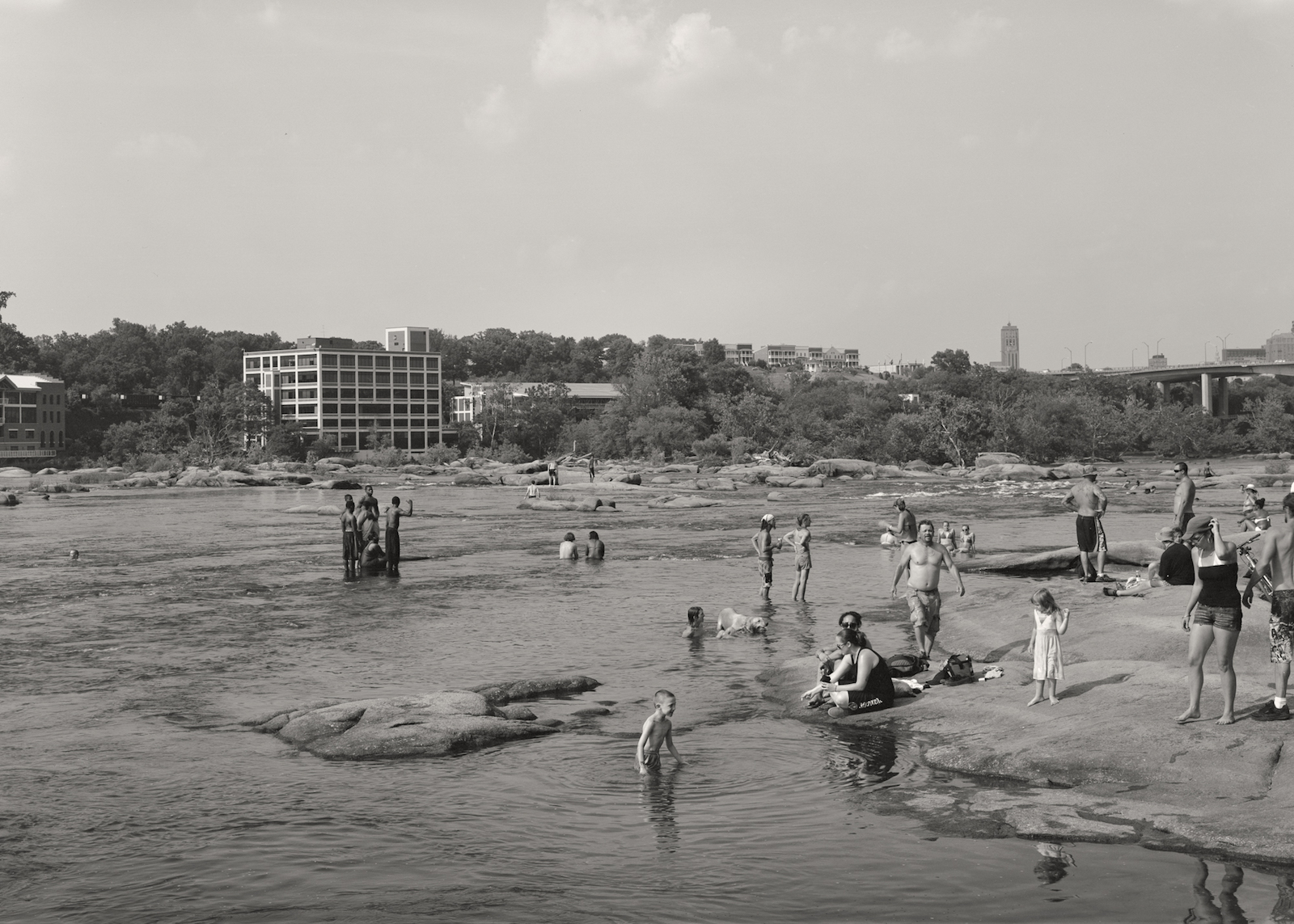
As American rivers have rebounded, some cities have redesigned and landscaped their urban waterfronts. In Woody’s photographs, the James River area has not been gentrified in this way. Belle Isle, in particular, bears the traces of its past lives as a fishery, an iron mill, a Confederate military prison, a quarry and stone-crushing plant, and a hydroelectric station. Woody’s pictures depict the liminality of shores, banks, and half-submerged rocks—the edges where land and water meet. But they also show us the layers of time as symbolized by abandoned bridges, smokestacks, and factories, along with contemporary infrastructure, like highways and electrical towers that reach up into the sky. Modern life rushes on overhead as people relax amidst the ruins in an unmade space.
Modern life rushes on overhead as people relax amidst the ruins in an unmade space.
The James River series includes both landscapes and portraits. But like space and time in these pictures, these categories refuse to stay fixed. They slide into each other and pile up, gesturing at the characteristics of both forms. Many of the landscapes feel like sets of portraits. The portraits in turn often feel like closely cropped landscapes, people posed in water, ruins, trees, and sky.
“James River, Richmond, VA, 2012” is so gorgeous it almost makes me cry. Everything —trees, power lines, a bridge pylon, and other industrial structures—is pushed to the edges, leaving the center for two teens walking in the water. They appear tiny, a nod to the scale of western landscape photographers like Carleton Watkins, and yet they are the same size as the electrical pylons in the background. The long exposure turns the moving water into a silver surface, a perfect void against the distinct textures of buildings, plants, and rocks. It’s a landscape that hints at a portrait. It’s also a metaphor: two young people carefully picking their way through life.
“Belle Isle, Richmond, VA, 2012” layers a set of portraits onto a wide landscape almost evenly divided between water moving over rocks and a riverbank and sky crowded with buildings and trees. The image feels old. Partially, it’s the technology—the large format camera and the use of film. It’s also late in the day and far into the history of human use of this river. Yet there are clues that we are in the present. Left of center, a tangle of Black boys wearing the long trunks of the twenty-first century look like they are standing on the water as they balance on a submerged rock around a Black girl who is sitting down. To the left of the group, a white man’s head floats on the surface of the river like a ball. To their right, closer to the middle, a white boy and a Black girl sit together in the flow. Above the mirrored water, people’s bodies reveal hidden differences beneath that surface, depths you cannot see. In the bottom right corner of the image, the portraits squeeze together. A long-haired young white man swims with a dog. A white boy plays in a pool between rocks as two white women look on. A white man with his hair pulled back by a bandana holds what looks like a tall beer. A white woman scratches her head under her cap as the little girl beside her pulls her hair in a similar gesture. It can’t be the past—this kind of easy integration in southern water did not exist in the era when those buildings were new.
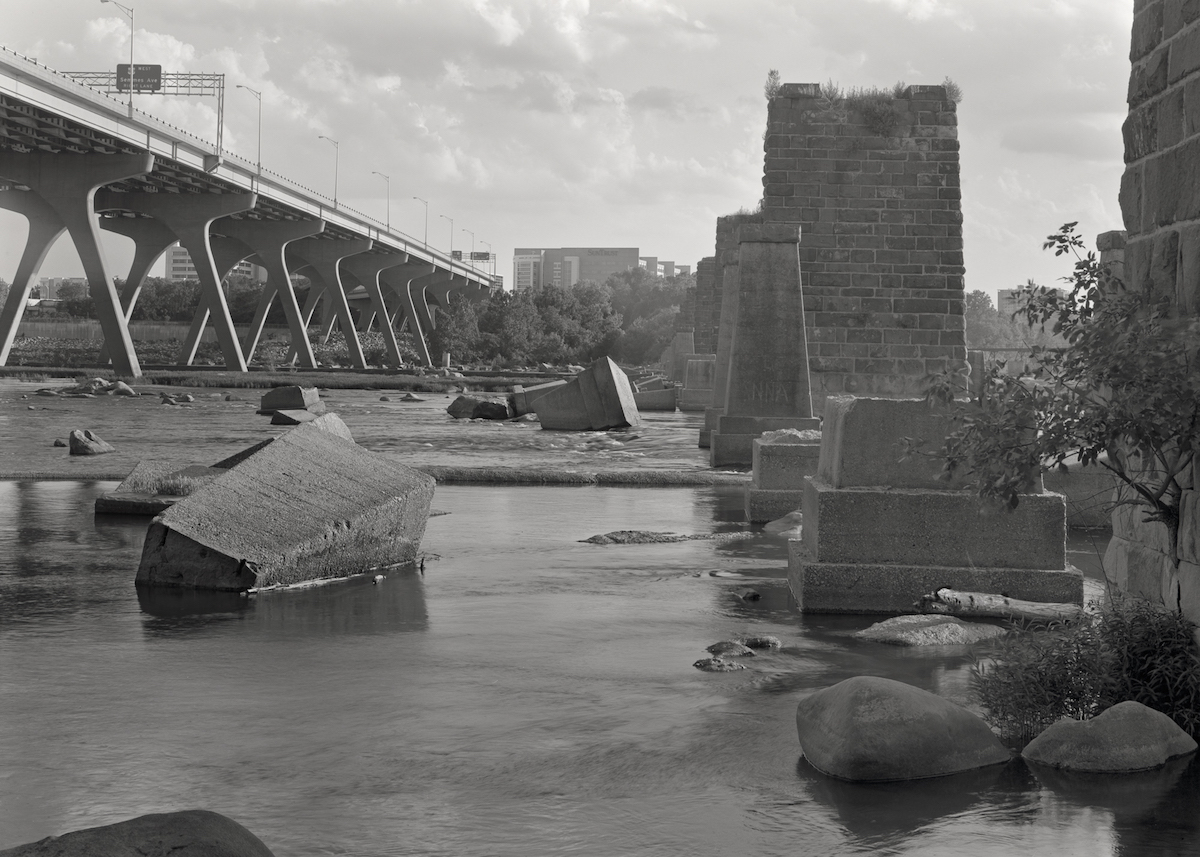
“James River, Richmond, VA 2012,” the only landscape here without people, deepens this sense of mystery. On the right, large blocks stand tall and yet are missing their bridge. Beside them, pieces of the smaller pylons of another span of bridge lay toppled in the water. This side of the image looks like it could have been ripped from Alexander Gardner’s Civil War Sketchbook, which also documented Richmond’s waterfront. Even the light looks old. The angle at which it hits the clouds makes clear that it is late in the day, an ending. The people are gone. Yet there, in the center of the horizon, a modern building, Suntrust, recedes into the haze. Just to the left, a spine of sleek concrete holds up a modern highway that shoots up at an angle and out of the top left corner of the frame. The photograph feels like a picture of an aftermath, although it’s not clear what exactly has happened and when.
In my favorite image here, “James River, Richmond, VA, 2013,” a white woman sits in water up to her shoulders in front of a rock that holds her sunglasses, what may be a crumpled pack of cigarettes, and a clear plastic bottle filled with transparent liquid, possibly baby oil. Behind her and to the right on the rock, someone—maybe it was her—has constructed a cross-shaped cairn. Its vertical shape echoes her head and the two electrical pylons in the left corner of the photograph, pulling your eye across the image in a zig-zag line. Just below her chest, the reflection of her head floats like an upside-down bust. Instead of looking at Woody taking the picture, the woman looks out the right side of the frame, and her averted gaze grants you permission to stare. It’s a perfect moment. Late in the day, the light is soft and so is her skin and the still and slightly reflective water. In contrast, the leaves of the plant growing out of the left end of the rock, the cracks and folds of the rock itself, and the old bricks piled to make the cairn are sharp and tactile. Every time I see it, I wonder how the soft, silver water can be that deep. I ponder the shape of her body under the surface, the part I can’t see. It’s a testament to the power of the photographic frame—I know from the other pictures that people gather here, that she probably does not have the river to herself, and yet the spell draws me in. It’s a beautiful picture of night swimming in the South, an evocation of the pleasure of being in water a little cooler than your body as the sun goes down.
It’s a testament to the power of the photographic frame—I know from the other pictures that people gather here, that she probably does not have the river to herself, and yet the spell draws me in.
Woody told me he loved the wildness of the kids “just flinging their bodies off the bridge supports” into the James. In “Brown’s Island, Richmond, VA, 2012,” three kids gather on an old structure as they look at the river. Again, the space is ambiguous. It’s not clear how high up they are or where the water is below them. The boy on the left stands on a ribbon of light that also gilds the outline of his head and a wayward strand of his hair. The other two kids seem removed, in a different world filled with a more diffuse light. Only the massive rectangular form of the bridge joins them. Another photo—“Brown’s Island, Richmond, VA, 2013”—shows one of those young bodies flying through the air, an echo of Aaron Siskind’s series, “Pleasures and Terrors of Levitation.”
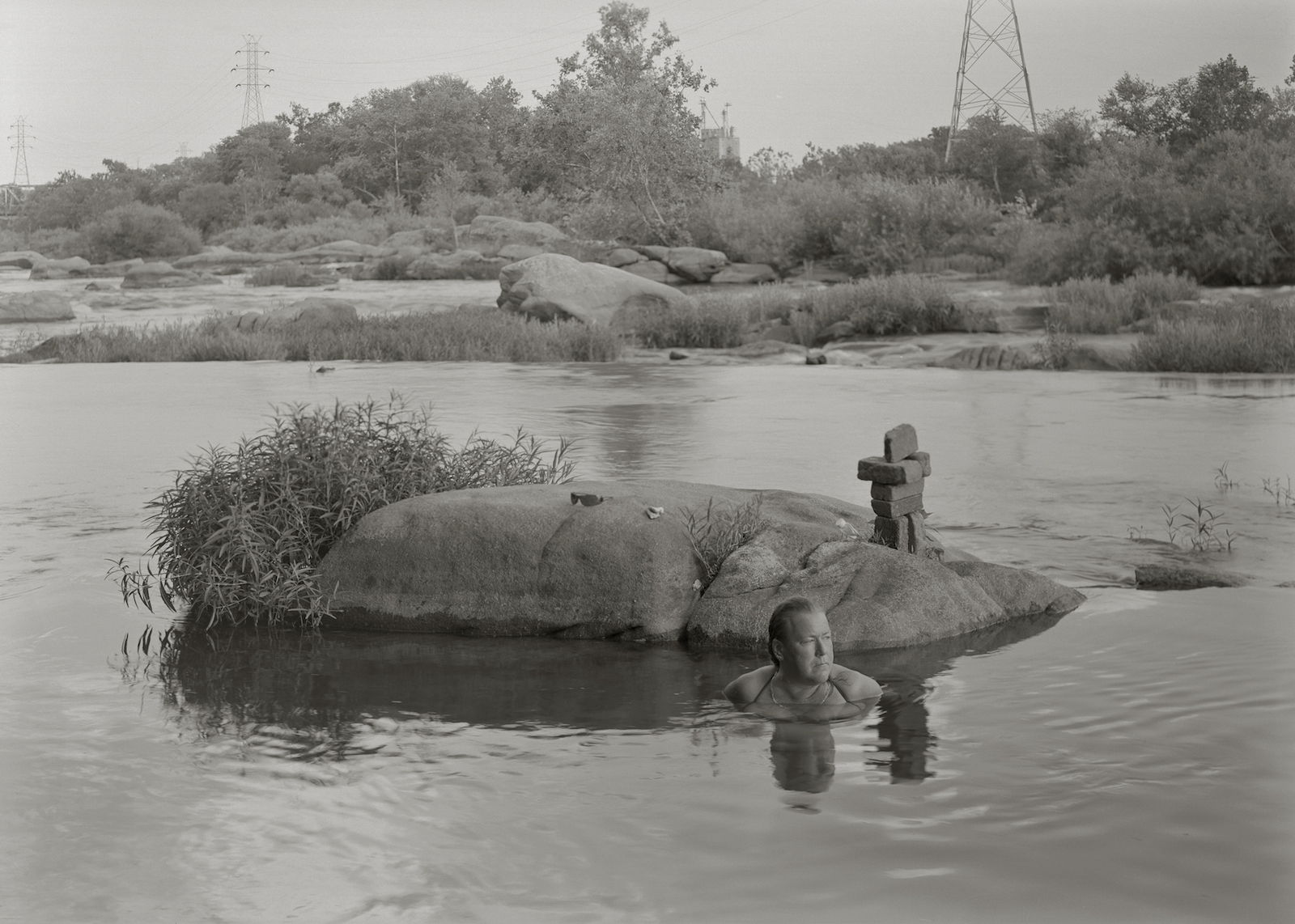
The two more formal portraits here, both labeled “Belle Isle, Richmond, VA, 2012,” demonstrate Woody’s astonishing talent as a portrait artist, his capacity to put people at ease. Perhaps his own history plays a role here. His mother, who moved to the United States from Korea as a young woman to study science, possesses a similar ability to draw others into her circle of care. Traveling through Colorado years ago, I experienced her warmth and generosity firsthand.
At work with his large format camera, Woody moves at a slow and gentle pace. He talks to people. He listens. He gives the people in his portraits the time to look at the camera and project what they want the viewer to see. Woody may be making a picture, but the composition feels like a collaboration. In all of Woody’s portraits, including a stunning image of three beautiful Black girls on the cusp of adulthood, his subjects own themselves.
People have always convened at the water. Yet in many American cities and towns, pollution has made that impossible. At the end of the last century, environmental activism and government regulation decreased the amount of waste pouring into many waterways. In the decades since, nature has not so much recovered as found a way to exist and even flourish amid the ruins. People have followed.
Dave Woody gives us a James River that has been used, abused, abandoned, and then reclaimed. His subjects gather and find respite here in communion with the water, the detritus of the past, and the infrastructure of the present. In these photographs, an alternate future, otherwise full of wonder and possibility, emerges, if only for the duration of the afternoon light.
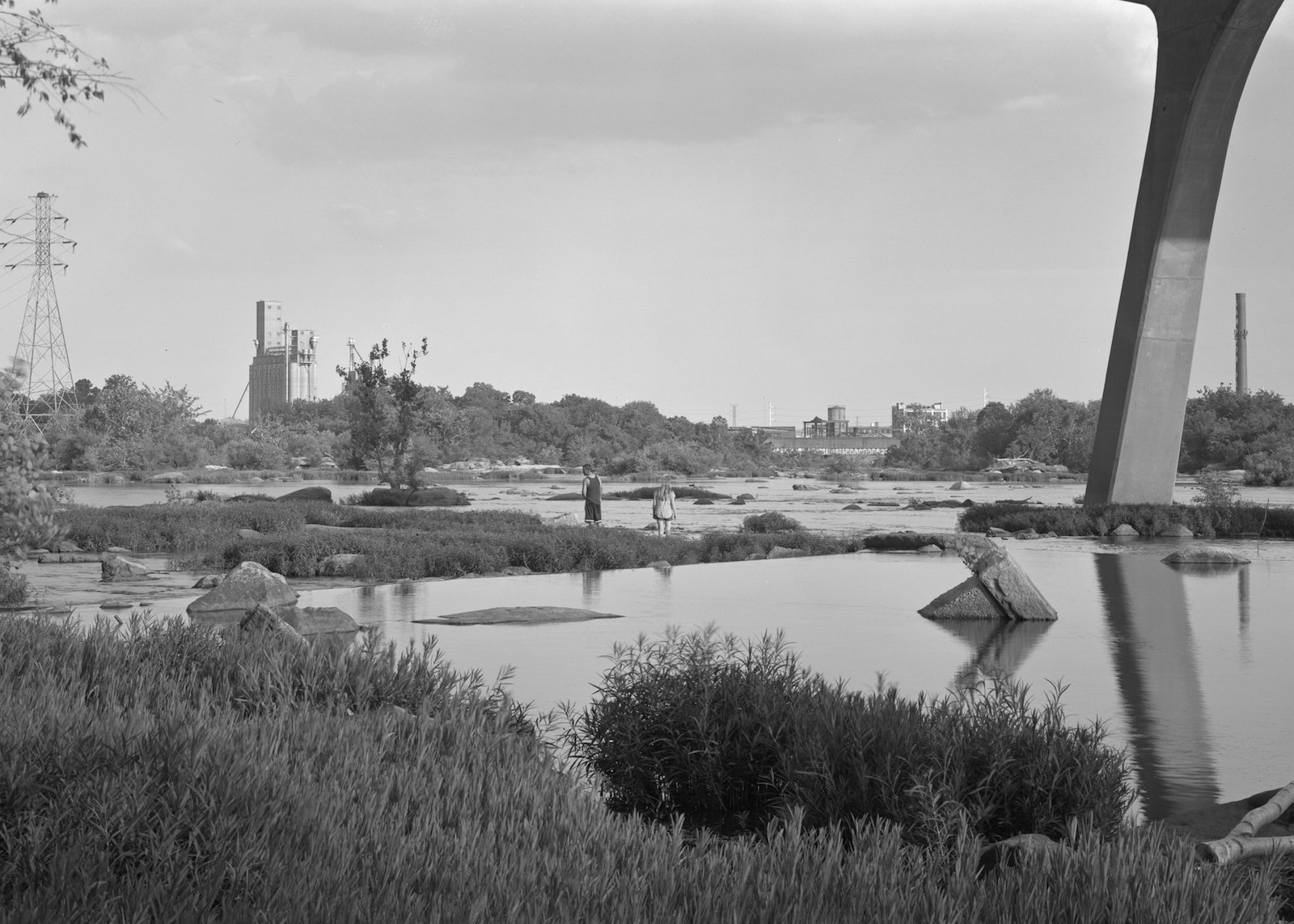
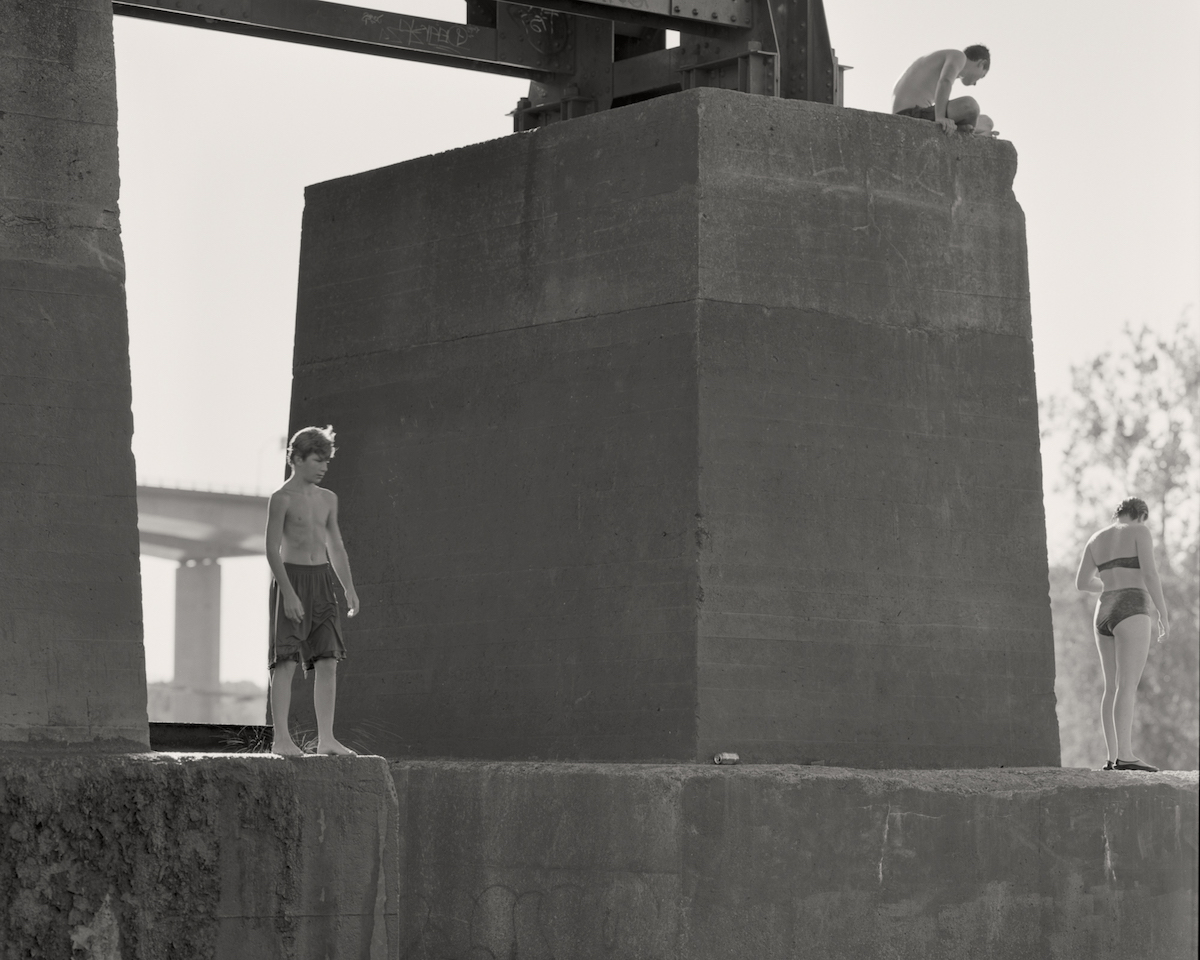
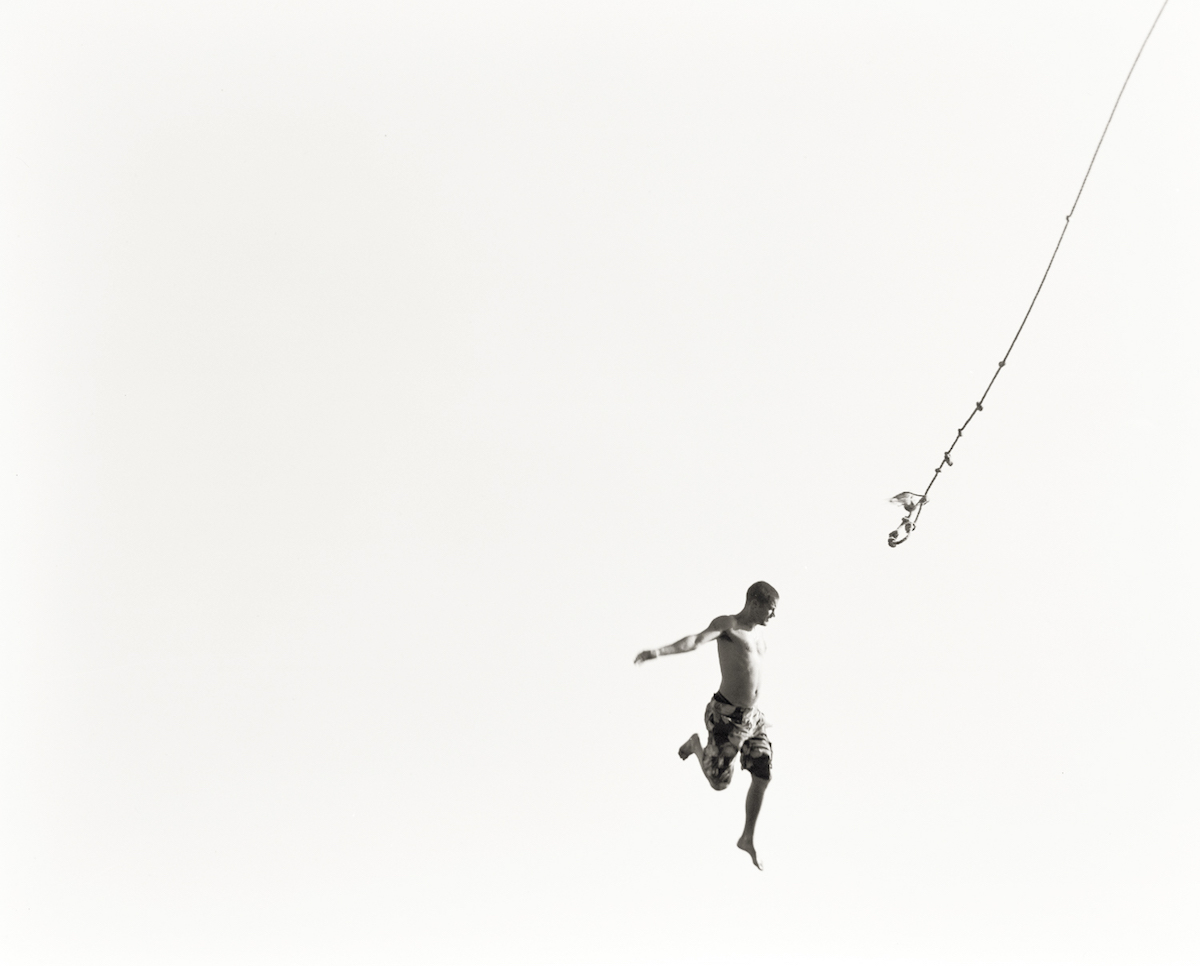
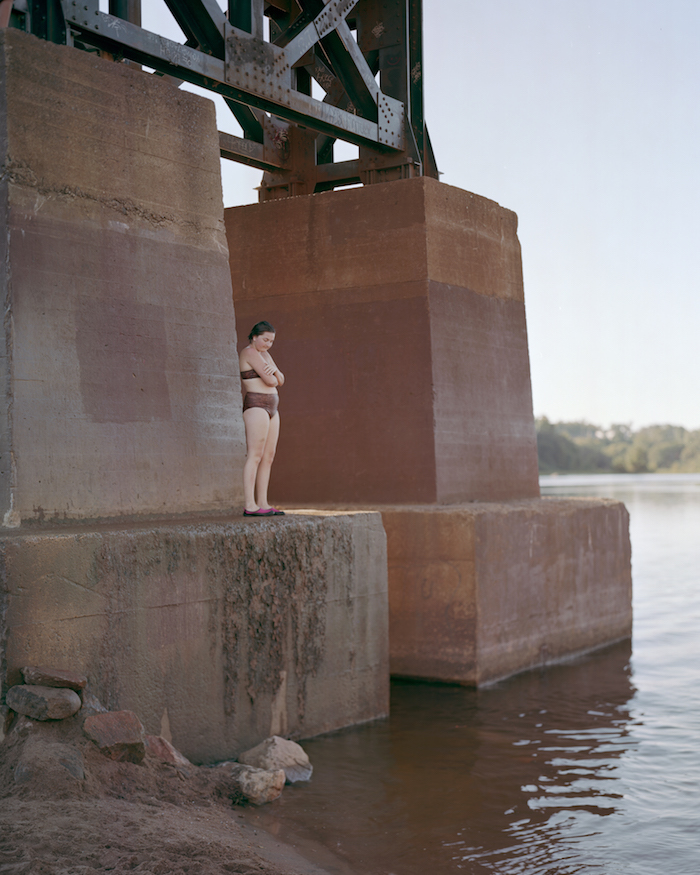
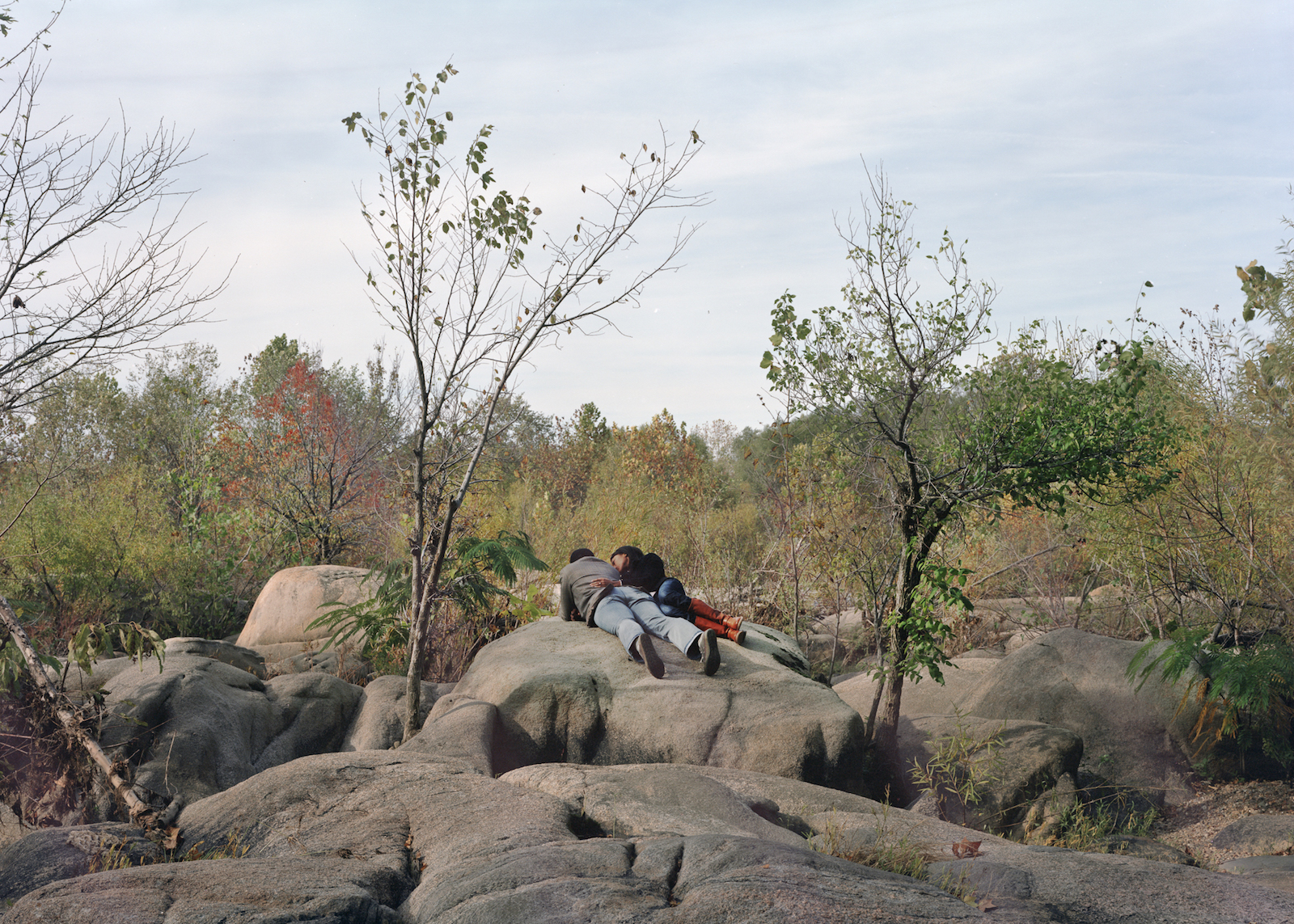
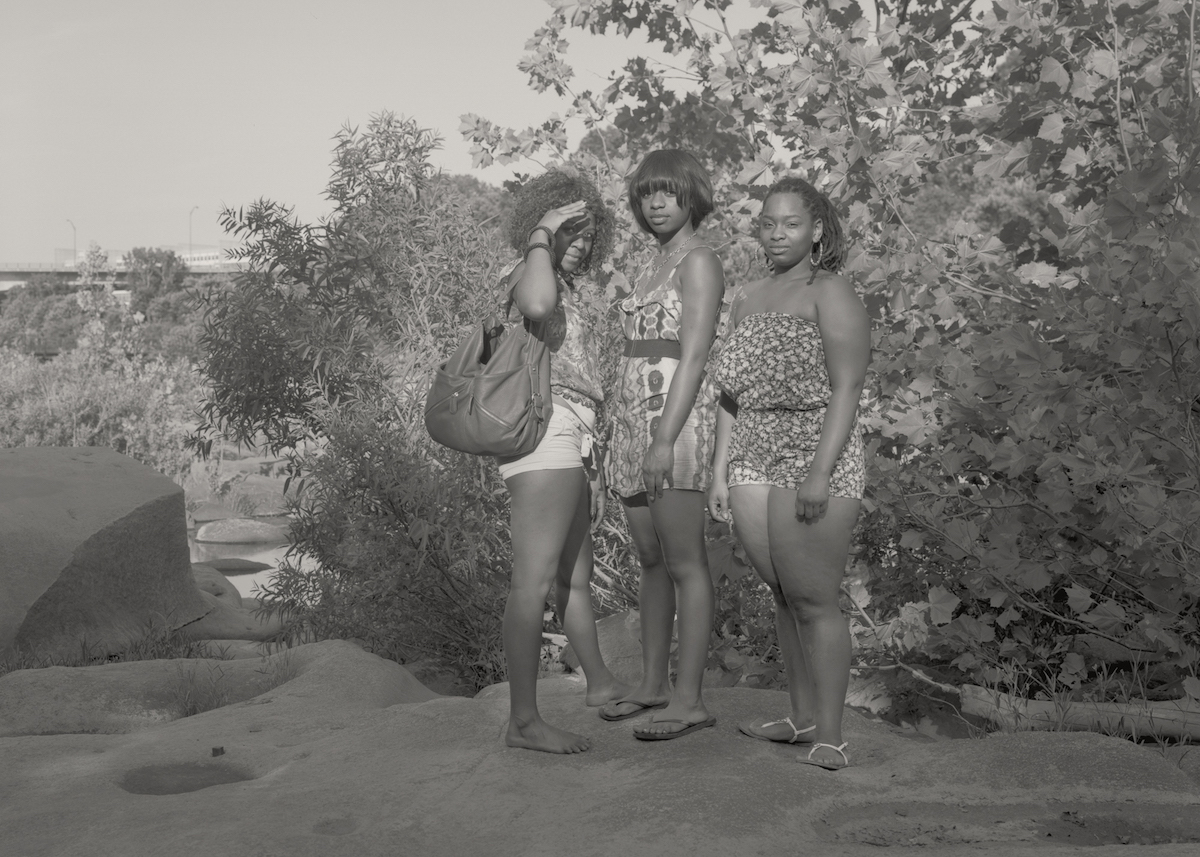
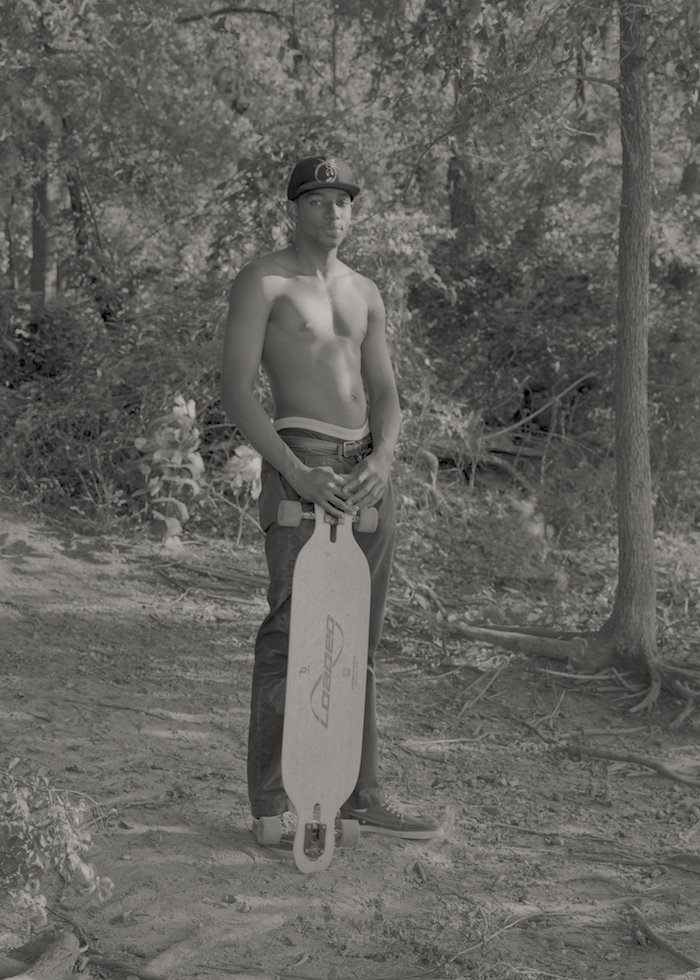
This essay is part of our Shutter photography series.
Grace Elizabeth Hale is Commonwealth Professor of American Studies and History at the University of Virginia and a 2018–2019 Carnegie Fellow. She is the author, most recently, of Cool Town: How Athens, Georgia Launched Alternative Music and Changed American Culture (2020). She has written for the New York Times, the Washington Post, Slate, American Scholar, and Southern Cultures. Her new book, forthcoming in 2022 from Houghton Mifflin Harcourt, is The Lyncher in the Family, is a history of her grandfather, a Mississippi sheriff, and white Americans’ inability to reckon with the history of white supremacy.

